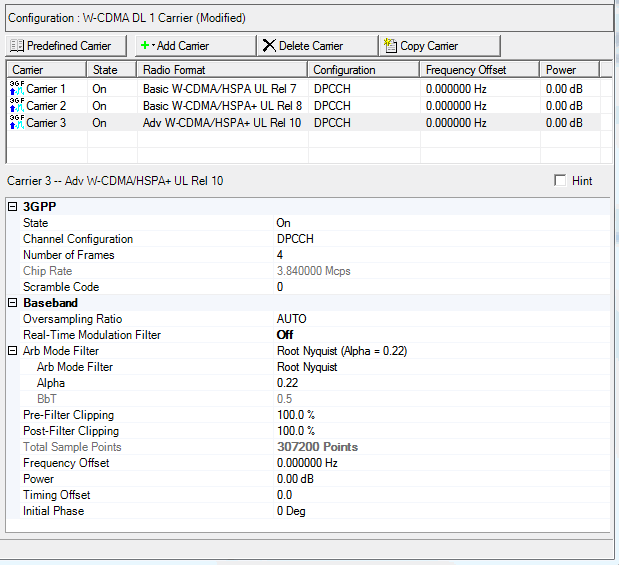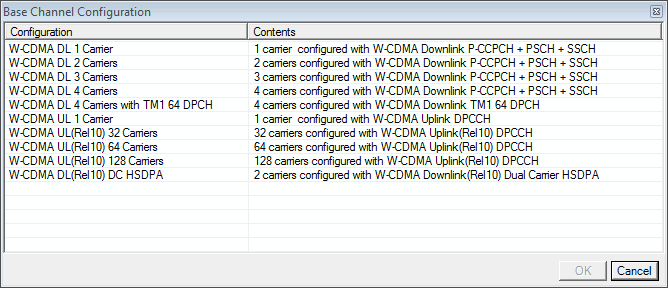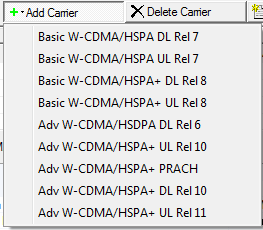Carrier n - Uplink

| 3GPP | Baseband | Arb Mode Filter |
|---|---|---|
|
|
||
|
|
||
|
|
||
|
|
||
|
|
||
|
|
|
|
|
|
|
|
|
|
|
| 3GPP CELL_FACH Parameters |
|---|
Not all of the parameters shown above appear in all carrier configurations. The figure above (and the CELL_FACH parameters) are a composite of all uplink carrier parameters and options, and is not a true representation of any one carrier type or channel configuration.
Carrier Configuration Summary Table
This table enables you to view the key parameters for each carrier in the waveform. You can also add or delete carriers using the buttons above the table (see descriptions below). Double-clicking a carrier row activates the setup tables for that carrier. You can use a maximum of 128 carriers.
 This button opens a window of
This button opens a window of  predefined carrier
configurations. Double-clicking a configuration replaces the current configuration
in the setup table. The uplink predefined carrier configuration uses channel parameters defined for a basic
carrier.
predefined carrier
configurations. Double-clicking a configuration replaces the current configuration
in the setup table. The uplink predefined carrier configuration uses channel parameters defined for a basic
carrier.
 This button opens a
This button opens a  drop-down
menu
for selecting a carrier to add to the setup table. The carrier is inserted
above the currently highlighted carrier in the table.
drop-down
menu
for selecting a carrier to add to the setup table. The carrier is inserted
above the currently highlighted carrier in the table.
 This button deletes the currently highlighted
carriers in the setup table. You can highlight multiple carriers by holding
down the CTRL key while selecting the carriers. You can also use the SHIFT
key to select a succession (group) of carriers.
This button deletes the currently highlighted
carriers in the setup table. You can highlight multiple carriers by holding
down the CTRL key while selecting the carriers. You can also use the SHIFT
key to select a succession (group) of carriers.
 An asterisk shown with a carrier entry indicates that
the parameters of a channel for that carrier have changed.
An asterisk shown with a carrier entry indicates that
the parameters of a channel for that carrier have changed.
 This button quickly adds a copy of the selected carrier in the carrier configuration summary table.
This button quickly adds a copy of the selected carrier in the carrier configuration summary table.
 An asterisk shown with a carrier entry indicates that
the parameters of a channel for that carrier have changed.
An asterisk shown with a carrier entry indicates that
the parameters of a channel for that carrier have changed.
3GPP
State
Double-click or use the drop-down menu to control the operating state of the carrier.
Channel Configuration
Double-click or use the drop-down menu to change the channel configuration.
Waveform Generation Length
Choices: 1 slot (0.66...ms) | 2 slots (1.33...ms) | 3 slots ( 2.0 ms) | 4 slots (2.66...ms) | 5 slots (3.33...ms) | 6 slots (4.0 ms) | 7 slots (4.66...ms) | 8 slots (5.33...ms) | 9 slots (6.0 ms) | 10 slots (6.66...ms) | 11 slots (7.33... ms) | 12 slots 8.0 ms) | 13 slots (8.66...ms) | 14 slots (9.333...ms) | 1 frame (10 ms)
Default: 1 frames (10 ms)
Select the waveform generation length.
When the waveform generation length valude is less than one frame (10 ms), set the Waveform Generation Offset value to create the waveform with the desired slot(s).
This parameter is available on only the Basic W-CDMA/HSPA DL/UL Rel 7 and Basic W-CDMA/HSPA+ DL/UL Rel 8 carriers.
Waveform Generation Offset
Range: 0–14
Default: 0
Sets the waveform generation offset. Enter an integer value by highlighting and replacing the current value. If just the number is highlighted and replaced, ensure that a space is present between the offset value and 'slot'. For example: 5 slot (3.33... ms), not 5slot (3.33... ms).
This parameter becomes active when the Waveform Generation Length setting is other than 1 frame (10 ms). The sum of the offset value and the Waveform Generation Length cannot be greater than 15 (15 slots in a radio frame). If the Waveform Generation Length is changed so that the sum would be greater than 15, the software changes the offset value so that the sum does not exceed 15.
This parameter is available on only the Basic W-CDMA/HSPA DL/UL Rel 7 and Basic W-CDMA/HSPA+ DL/UL Rel 8 carriers.
Number of Frames
Range: 1–1022
Default: 4
This setting requires the advanced Option Qxx and is available with only the carrier.
Enter a value to set the number of frames in your waveform.
The waveform length in a multi-carrier waveform is determined by the least common multiple (LCM) of the waveform lengths (measured in number of frames) of all the carriers. Carriers with waveform lengths less than the LCM are repeated until the multi-carrier waveform length matches the LCM. For example, if a waveform is comprised of two carriers, where carrier A is 10 frames and carrier B is 3 frames, A is repeated 3 times and B is repeated 10 times. This results in a multi-carrier waveform length of 30 frames, the LCM of carrier A and B.
The maximum waveform length depends on the oversampling ratio, number of carriers, and available PC memory. If an out-of-memory error is reported, reduce the number of frames, number of carriers, or the maximum frequency offset. Reducing the frequency offset reduces the oversampling ratio, which reduces the amount of PC memory required.
Chip Rate
View the W-CDMA signal chip rate (3.84 Mcps). You cannot edit this cell.
Scramble Code
Range: 0–16777215
Enter the uplink scramble code. It provides a unique signature for the base station.
The uplink scramble code is used to encode the DPCH.
Tprach-dpcch
Range: 18944–26368
Default: 18944
Enter a time interval value (in chips) between the last preamble and first dpcch.
Number of Preamble
Range: 1–1022
Default: 4
Enter the number frames for the preamble.
The maximum waveform length depends on the oversampling ratio, number of carriers, and available PC memory. If an out-of-memory error is reported, reduce the number of frames, number of carriers, or the maximum frequency offset. Reducing the frequency offset reduces the oversampling ratio, which reduces the amount of PC memory required.
Number of DPCCH
Range: 1–1022
Default: 4
Enter the number frames for the DPCCH.
The maximum waveform length depends on the oversampling ratio, number of carriers, and available PC memory. If an out-of-memory error is reported, reduce the number of frames, number of carriers, or the maximum frequency offset. Reducing the frequency offset reduces the oversampling ratio, which reduces the amount of PC memory required.
Number of E-DPCCH and E-DPDCH
Range: 1–1022
Default: 4
Enter the number frames for the E-DPCCH and E-DPDCH.
The maximum waveform length depends on the oversampling ratio, number of carriers, and available PC memory. If an out-of-memory error is reported, reduce the number of frames, number of carriers, or the maximum frequency offset. Reducing the frequency offset reduces the oversampling ratio, which reduces the amount of PC memory required.
Baseband
Oversampling Ratio
Range: 0–50 | Auto
Default: Auto
Double-click or use the pull-down menu to set the oversampling ratio.
The Total Sample Points value (number of points) is automatically determined based on the oversampling ratio. Using a larger oversampling ratio results in a more completely filtered image, but also uses more waveform memory by increasing the number of waveform points. Choose to let the signal generator automatically select the optimized oversample ratio for the current signal setup.
The oversampling ratio must be set to any value other than 1 in order to select a filter type. An oversampling ratio of 1 automatically selects as the filter type and makes associated filter parameters unavailable.
This parameter is coupled with the Real-Time Modulation Filter and Frequency Offset settings:
-
Use the following formula to calculate the minimum oversampling ratio:
minimum oversampling ratio = (3.84 MHz + 2(2.5 MHz + Frequency Offset))/3.84 MHz
-
Round all decimal values to the next higher oversampling number. For example, if the calculated value is 12.1, select 13 as the minimum oversampling ratio value.
Real-Time Modulation Filter
Choices: Off | On
Default: On
The E4438C ESG, N5182A MXG, N5172B EXG, and N5182B MXG vector signal generators are the only instruments that support the Real-Time Modulation Filter. For this software, it supports this feature with Option Qxx and its and carriers.
When set to On, the software creates a waveform with an oversampling ratio of one and without any filtering. When played back, the signal generator uses the real-time modulation filter to increase the oversampling ratio and to provide the correct filtering. For more information and to view the signal generator filter settings, refer to the topic.
The purpose of this filter is to allow the signal generator storage of a large waveform file that, if created using the software filters, may exceed the memory capacity of the signal generator. This feature is especially useful for creating a waveform to transmit a full PN9 sequence for BER testing.
When turned on, the selection changes to and the other filter settings gray out (the signal generator provides the filtering in real-time). Also the selection sets to and it cannot be changed.
Filter or Arb Mode Filter
The software uses the cell name with the Adv W-CDMA/HSPA+ UL Rel 8 carrier. This carrier requires Option Qxx. The filter selection turns to when the Real-Time Modulation filter is turned on.
View the selected filter type and associated parameter.
The software uses the cell name with the Adv W-CDMA/HSPA+ UL Rel 8 carrier. This carrier requires Option Qxx. This setting shows and grays out when the Real-Time Modulation Filter is turned on.
Double-click or use the pull-down menu to set the baseband filter type:
-
None
-
Nyquist
-
Root Nyquist
-
Rectangle
-
Gaussian
If the oversampling ratio is set to 1, the filter type is automatically set to None, and the filter types and corresponding filter parameters are not available.
If the oversampling ratio is set to any other value, you can select one of the listed filter types and edit the associated parameters.
Alpha
Change the Alpha parameter for Root Nyquist and Nyquist filters. This field grays out with any other filter selection and also while the Real-Time Modulation Filter is on.
BbT
Change the BbT parameter for a Gaussian filter. This field is grays out with any other filter selection and also while the Real-Time Modulation Filter is on.
Pre-Filter Clipping
Range: 10–100%
Set the clip (limit) level of the I/Q waveform before filtering. A level of 100.0% equates to no clipping.
Post-Filter Clipping
Range: 10–100%
Set the clip (limit) level of the I/Q waveform after filtering. A level of 100.0% equates to no clipping.
Total Sample Points
View the total sample points in the waveform. You cannot edit this cell.
Total sample points is directly related to the Oversampling Ratio value selected. The higher the Oversampling Ratio, the more sample points:
|
Oversampling Ratio |
Total Sample Points |
|---|---|
|
1 |
38400 |
|
2 |
76800 |
|
|
|
|
50 |
2754995200 |
Cubic Metric
View the Cubic Metric value. You cannot edit this cell. See Understanding the Cubic Metric for more information.
Cubic Metric Reference Signal rms
Sets the reference signal's rms value, in dB, used for calculating the Cubic Metric. See Calculating the Cubic Metric for more information.
Cubic Metric k Value
Choice: 1.5600 | 1.8500
Default: 1.8500
Sets the empirical factor (k) for calculating the Cubic Metric. See Calculating the Cubic Metric for more information.
Frequency Offset
Range:
N5182B : –76.5 to 76.5 MHz (Option 657)
N5172B : –56.5 to 56.5 MHz (Option 655)
N5182A: –49.5 to 49.5 MHz
E4438C: –39.5 to 39.5 MHz
E8267D: –39.5 to 39.5 MHz
N5106A: –49.5 to 49.5 MHz
E6607: –49.5 to 49.5 MHz
Default:
0 Hz
Set the carrier's frequency offset relative to the signal generator's frequency setting.
This parameter is coupled with Oversampling Ratio.
Power
Range: −65 to 0 dB
Default: 0 dB
Use this cell to set the relative power level for the selected carrier in a multiple carrier configuration. To set the power level for a single carrier configuration, use the cell in the Instrument view.
In a multiple carrier configuration, each carrier's power level is set relative to the signal generator's RF power level. The signal generator distributes the RF power among the carriers while maintaining their power ratios. For example with two carriers set to 0 dB, each carrier is at the same power level but both carriers are -3 dB down from the reference. As you increase the number of carriers, the power level decreases the same amount for each carrier.
Timing Offset
Range: 0–149, in 0.5 steps
Default: 0
Set the carrier's timing offset.
Timing offset values increment by 256 chips for each half (0.5) step and by 512 chips for each whole step.
Physical channels summed in phase produce a high crest factor (high peak-to-average ratio). Offsetting the timing can minimize the crest factor by changing this phase relationship.
Initial Phase
Range: 0–359 degrees
Default: 0
Set the initial phase of the carrier.


